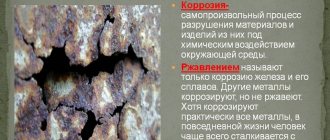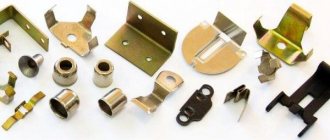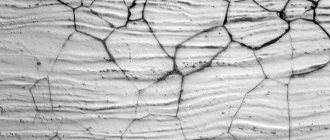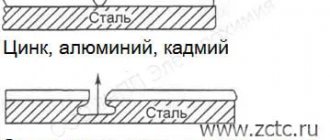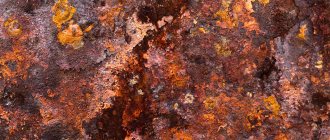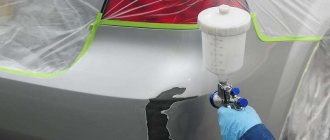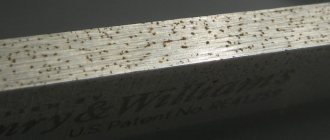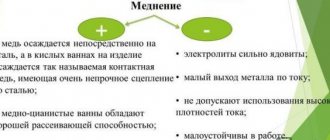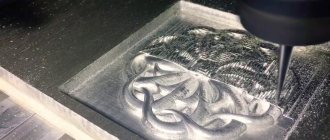Aluminum and its reaction with water
Aluminum was first produced only at the beginning of the 19th century. This was done by physicist Hans Oersted. He conducted his experiment with potassium amalgam, aluminum chloride and mercury.
By the way, the name of this silvery material comes from the Latin word “alum”, because it is from them that this element is mined.
Alum [Wikimedia]
Alum is a natural metal-based mineral that combines sulfuric acid salts in its composition.
Previously, aluminum was considered a precious metal and was worth an order of magnitude more expensive than gold. This was explained by the fact that the metal was quite difficult to separate from impurities. So only rich and influential people could afford aluminum jewelry.
Japanese aluminum decoration [Wikimedia]
But in 1886, Charles Hall came up with a method for extracting aluminum on an industrial scale, which dramatically reduced the cost of this metal and made it possible to use it in metallurgical production. The industrial method involved the electrolysis of molten cryolite in which aluminum oxide was dissolved.
Aluminum is a very popular metal, because many things that people use in everyday life are made from it.
Application of aluminum
Due to its malleability and lightness, as well as its resistance to corrosion, aluminum is a valuable metal in modern industry. Aluminum is not only used to make kitchenware; it is widely used in automobile and aircraft construction.
Aluminum is also one of the most inexpensive and economical materials, as it can be used endlessly by melting down unwanted aluminum items, such as cans.
Aluminum cans
Aluminum metal is safe, but its compounds can be toxic to humans and animals (especially aluminum chloride, acetate and sulfate).
Physical properties of aluminum
Aluminum is a fairly light, silver-colored metal that can form alloys with most metals, especially copper, magnesium and silicon. It is also very plastic; it can easily be turned into a thin plate or foil. The melting point of aluminum = 660 °C and the boiling point is 2470 °C.
Chemical properties of aluminum
At room temperature, the metal is coated with a durable film of aluminum oxide Al₂O₃, which protects it from corrosion.
Aluminum practically does not react with oxidizing agents due to the oxide film that protects it. However, it can be easily destroyed so that the metal exhibits active restorative properties. The aluminum oxide film can be destroyed with a solution or melt of alkalis, acids, or with the help of mercury chloride.
Due to its reducing properties, aluminum has found application in industry for the production of other metals. This process is called aluminothermy. This feature of aluminum is its interaction with oxides of other metals.
Aluminothermic reaction involving iron (III) oxide [Wikimedia]
For example, consider the reaction with chromium oxide:
Cr₂O₃ + Al = Al₂O₃ + Cr.
Aluminum reacts well with simple substances. For example, with halogens (except fluorine), aluminum can form aluminum iodide, chloride, or bromide:
2Al + 3Cl₂ → 2AlCl₃
With other non-metals such as fluorine, sulfur, nitrogen, carbon, etc. aluminum can only react when heated.
Silver metal also reacts with complex chemicals. For example, with alkalis it forms aluminates, that is, complex compounds that are actively used in the paper and textile industries. Moreover, it reacts as aluminum hydroxide
Al(OH)₃ + NaOH = Na[Al(OH)₄]),
and metallic aluminum or aluminum oxide:
2Al + 2NaOH + 6Н₂О = 2Na[Al(OH)₄] + ЗН₂.
Al₂O₃ + 2NaOH + 3H₂O = 2Na[Al(OH)₄]
Aluminum reacts quite calmly with aggressive acids (for example, sulfuric and hydrochloric acids), without ignition.
If you dip a piece of metal into hydrochloric acid, the reaction will be slow—at first the oxide film will dissolve—but then it will speed up. Aluminum dissolves in hydrochloric acid, releasing hydrogen. The reaction results in aluminum chloride:
Al₂O₃ + 6HCl = 2AlCl₃ + 3H₂O
2Al + 6HCl → 2AlCl₃ + 3H₂.
Aluminum chloride [Wikimedia]
Here you will find interesting experiments to study the chemical properties of metals.
Reaction of aluminum with water
If you put aluminum shavings in ordinary water, nothing will happen because the aluminum is protected by an oxide film that prevents this metal from reacting.
Only by removing the protective film with mercury chloride can you get the result. To do this, the metal must be soaked in a solution of mercuric chloride for two minutes, and then rinsed well. The result is an amalgam, an alloy of mercury and aluminum:
3HgCI₂ + 2Al = 2AlCI₃ + 3Hg
Moreover, it does not stick to the metal surface. Now, by immersing the purified metal in water, you can observe a slow reaction, which is accompanied by the release of hydrogen and the formation of aluminum hydroxide:
2Al + 6H₂O = 2Al(OH)₃ + 3H₂.
Source: https://melscience.com/ru/articles/alyuminij-i-ego-reakciya-s-vodoj/
Ways to combat aluminum corrosion
Aluminum is a metal widely used in industry and everyday life. Aluminum does not oxidize in air. Its inertness is due to the thin oxide film that protects it. However, under the influence of certain environmental factors, this metal is still subject to destructive processes, and corrosion of aluminum is not such a rare phenomenon.
Types of corrosion
Aluminum oxidizes quickly in the atmosphere, but to a shallow depth. This is prevented by a protective oxide film. Oxidation accelerates above the melting point of aluminum. If the integrity of the oxide film is compromised, aluminum begins to corrode. The reasons for the thinning of its protective layer can be various factors, from exposure to acids, alkalis and ending with mechanical damage.
Aluminum corrosion is the self-destruction of metal under the influence of the environment. According to the flow mechanism, they are distinguished:
- Chemical corrosion - occurs in a gas environment without the participation of water.
- Electrochemical corrosion – occurs in humid environments.
- Gas destruction - but accompanies heating and hot processing of aluminum. As a result of the interaction of oxygen with metals, a dense oxide film appears. This is why aluminum does not rust, like all non-ferrous metals.
On video: electrochemical corrosion of metals and methods of protection.
Causes of aluminum corrosion
The corrosion resistance of aluminum depends on several factors:
- purity - the presence of impurities in the metal;
- exposure environment - aluminum can be equally susceptible to destruction in clean rural air and in industrially polluted areas;
- temperature.
In many cases, low-concentration acids can dissolve aluminum. The natural oxide film does not protect against corrosion.
Powerful destroyers are fluorine, potassium, sodium. Aluminum and its alloys corrode when exposed to chemical compounds of bromine and chlorine, lime and cement solutions.
Corrosion of aluminum and its alloys occurs in water, air, carbon and sulfur oxides, and salt solutions. Sea water leads to accelerated destruction. Aluminum is considered an active metal, but it also has good corrosion properties.
There are two main factors that influence the intensity of the corrosion process:
- degree of aggressiveness of the acting environment - humidity, pollution, smoke;
- chemical structure.
Suzuki Escudo BRUTUS › Logbook › Aluminum on iron – evil? or cognitive corrosion.
Where do we usually start when adding functionality to our machines? That's right - from visiting websites and forums to see how others have implemented similar ideas, to pick up something interesting and not to make the mistakes of others. But is it always worth believing what is written on forums? Someone else's experience is not always the truth and is rarely described by a person who has achieved Zen in this matter. I remember my first posts - I wrote such nonsense, and even defended my rightness, and so convincingly. But someone can take advantage of this. I also remember reading before, where I no longer remember, that under no circumstances should you trim the body with aluminum. It sounded something like this: “Guys, haven’t you studied physics at all?! When aluminum and iron come into contact, you create a galvanic couple and within six months your entire body will rot and dissolve! You have to think with your head at least sometimes!” A galvanic couple is created, yes, but will the result be so disastrous? More on this later. In my new profession, they sent me to study for advanced training at the Ufa State Petroleum Technical University, where for two weeks candidates of technical sciences told me about metal corrosion and how to deal with it. This article will not be scientific and journalistic, so as not to bother you, I will try to tell everything using the example of apples, figuratively. So, according to the mechanism of its occurrence, corrosion is divided into chemical and electrochemical. Chemical corrosion occurs in a non-electrolytic environment at high temperatures. Since we are considering a car body, this type of corrosion is not applicable. We are interested in electrochemical corrosion, in which moisture acts as the electrolyte. From the course of physics and chemistry, we all remember that all metals have a crystal lattice in which electrons move freely and such a lattice is called a metal bond. This bond of atoms is not very strong and its properties allow us to actively use these materials in our lives. But the fact that it is not strong gives us problems. For example, water dipoles (and water, due to its structure, is a rather aggressive medium) break metal bonds and this occurs most actively in places where the number of electrons is insufficient, pulling out metal molecules and creating a more stable connection with them. These places are hotbeds of corrosion. How do areas of metal with a small number of electrons appear? This is due precisely to the ability of electrons to move freely in the crystal lattice of the metal. All metals have a natural potential (electrostatic) that is different from zero. Iron in natural conditions has a potential equal to approximately -0.44 Volts, zinc -0.76 V, aluminum -1.67 V, magnesium -2.3 V. But even a metal of the same nature, for example, a sheet of iron, has different parts have different potentials. Slightly, but different. This is due to various reasons, including mechanical stress in the metal structure, various inclusions, sharp edges, burrs, scratches, peening, welding seams, etc. Such places have a more negative potential in relation to other parts and they are anode zones, i.e. anodes (the remaining parts are cathodes, respectively). When electrochemical corrosion occurs in the electrolyte, the anode saturates the cathode with electrons through the conductor, thereby losing the strength of the molecular bond and is destroyed under the influence of an aggressive environment. Remember the places where the body most often rots - these are body folds, seams, connections of various parts, etc., i.e. in places where moisture is present and there are additional factors that create anodic zones. The same flooring on our cars does not rot evenly over the entire area. Lesions begin to develop in corners and folds. Each of you can conduct one small and simple experiment as confirmation: Take two identical nails. Bend one of them 90 degrees. Then degrease both and, without touching them with your fingers (you can take them with a piece of paper), place them in a solution of table salt (NaCl). Corrosion will be most intense on a bent nail at the bend. On a straight nail it will flow more evenly over the entire area and less intensely. Anyone who has ever dismantled wooden buildings with rusty nails can remember that bent nails in the bends break very easily and almost the entire broken area is rusty through and through. The body is protected from corrosion by insulation, which consists of paint and primer. But there is one point - in places where the insulation is broken, corrosion will develop more intensively than if the entire metal were bare, without insulation. So what effect does aluminum have on iron at the points of contact? Metals with a more negative natural potential when in contact with iron act as an anode, i.e. protect metal from corrosion. These metals include zinc, aluminum and magnesium. Those. When finishing the body with aluminum, in the presence of an electrolyte between them, aluminum will act as an anode and it is this that will be destroyed. This process is lengthy, and given that aluminum rarely bears serious mechanical loads, it is also painless. The sacrificial protection of metal structures from corrosion, for example, oil pipelines, is based on this principle. Of course, no one here gives you guarantees that by laying a sheet of aluminum on the floor you will completely protect the body from corrosion. This process is influenced by many factors, including currents flowing through the body from electrical receivers, various aggressive environments, spilled oils, chemical liquids, etc. But you can’t make things worse with aluminum, quite the contrary. It is also worth noting here that in places where the body comes into contact with metals that have a lower natural potential in relation to iron, iron will no longer be a cathode, but will become an anode, as a result the corrosion process will proceed more intensely. Such metals include nickel, tin, lead, copper. Silver and gold too, but I don’t think you have them lying around in your cars.
Main types of aluminum corrosion
Aluminum and, to varying degrees, its alloys are highly resistant to corrosion even without any special protective coating.
Natural oxide coating
The natural surface of aluminum, which is created during the manufacturing of an aluminum product, such as extrusion, rolling or casting, has high resistance to corrosion in most types of environments. This occurs because a fresh aluminum surface spontaneously and instantly forms a thin but very effective oxide layer that prevents further oxidation of the metal.
This oxide film is impermeable and, unlike the oxide films of other metals, such as iron, is very firmly “attached” to the base metal. In case of any mechanical damage, this film is instantly restored and healed.
The natural oxide layer is the main reason for aluminum's good resistance to corrosion. This coating is resistant in environments with acidity - pH value - from 4 to 9.
Three main types of aluminum corrosion
The most common types of aluminum corrosion are:
- galvanic (contact) corrosion;
- pitting (pitting) corrosion;
- crevice corrosion.
Stress corrosion, which leads to cracking, is a more specific type of corrosion. It occurs primarily in high-strength aluminum alloys, such as AlZnMg alloys, when they are subjected to prolonged tensile stress in the presence of a corrosive environment. This type of corrosion does not usually occur in 6xxx series alloys, i.e. AlMgSi alloys.
Galvanic corrosion of aluminum
Galvanic corrosion can occur when two different metals are in direct contact and an electrolytic bridge has formed between them. The less noble metal in this combination becomes the anode and corrodes. The more noble metal becomes the cathode and is protected from corrosion.
In most combinations with other metals, aluminum is the less noble metal. Aluminum is therefore at higher risk of galvanic corrosion than other building materials. However, this risk is less than is generally believed.
Necessary conditions: contact and moisture
Galvanic corrosion of aluminum occurs only when simultaneously:
- there is contact with a more noble metal (or other electrical conductor with a higher chemical potential than aluminum, such as graphite;
- between two metals there is an electrolyte with good conductivity, most often water with dissolved salts.
Galvanic corrosion does not occur in a dry air atmosphere, such as inside a normal living space. There is no big risk of galvanic corrosion and a clean rural atmosphere. However, the risk of galvanic corrosion must always be taken into account in atmospheres with high chloride content, for example in areas near seas and oceans.
Aluminum and galvanized steel
There may be problems with galvanic corrosion when pairing aluminum with galvanized steel. The zinc coating on galvanized steel will initially protect the aluminum from corrosion.
However, this protection decreases when the surface of the steel begins to be exposed as the zinc is consumed. Hot-dip galvanizing of steel produces a thicker zinc coating than electrochemical galvanizing and provides longer-lasting protection for aluminum.
Therefore, in aggressive atmospheres in contact with aluminum, only hot-dip galvanized steel is used.
Electrical insulation
Where different metals are used in contact, galvanic corrosion can be avoided by electrically isolating one metal from the other. An example of such a solution for a bolted connection between an aluminum and steel sheet is shown in Figure 1.
Electrolyte may form between the bolt head and the surface of the aluminum, but the electrically insulating washer will not allow galvanic electric current to flow and corrosion will not occur.
On the other hand, there is no possibility of moisture ingress in the contact between aluminum and steel sheets, electrolyte is not formed and corrosion does not occur.
Mechanical coating
How to protect aluminum from corrosion? The most commonly used mechanical method is applying a layer of paint.
Paint the product and you will see the effectiveness of this method. Painting can be wet and dry, or powder. These technologies will improve. In wet painting, paint layers are applied after protecting the aluminum with a composition containing zinc and strontium compounds. The metal base is carefully prepared: protected, polished, dried. The primer is applied in stages.
When the solvent from the primer mixture has completely disappeared, the surface can be coated with an insulating composition: oil or glyphthalic varnish.
Special compounds help stop corrosion and protect aluminum structures from chemicals, gasoline, and various types of oils. The choice of coating depends on the conditions of subsequent use of the metal product:
- hammer - used to obtain structures of various color shades used in decoration;
- bakelite - applied under high pressure, filling microcracks and pores.
Powder painting requires thorough cleaning of the surface from grease and various deposits. This is achieved by immersion in alkaline or acidic solutions with the addition of wetting agents. Next, a layer of chromate, phosphate, zirconium or titanium compounds is applied to the aluminum structures. After this it will not oxidize.
After drying the material, a protective polymer is applied to the oxidized area. The most commonly used are polyesters that are resistant to mechanical, chemical and thermal influences. Polymerized urethane, epoxy and acrylic powders are used.
Corrosion of aluminum and methods of its protection
Aluminum and its alloys are characterized by excellent resistance to various types of damage. However, despite this, corrosion of aluminum is not such a rare phenomenon. Various forms of corrosion represent the main cause of deterioration of these materials. To combat destructive processes, it is imperative to understand the factors that cause their occurrence.
Aluminum corrosion is a reaction that takes place between the metal and its environment. This process can be of either natural or chemical origin. The most common form of metal destruction is the appearance of rusting processes on its surface.
A special feature of all types of metals is their ability to react with water and the environment. The only difference for each type of metal is the intensity of this process. For example, for noble metals such as gold, the rate of such a reaction will not be too fast, but iron, including aluminum, will react to influences of this nature quite quickly.
Two factors can be distinguished that have a direct impact on the intensity of the corrosion process. One of them can be called the degree of aggressiveness of the environment, and the second is the metallurgical or chemical structure. The atmosphere that surrounds us is always characterized by a certain level of humidity. In addition, it is characterized by a certain level of pollution and waste.
If we consider that the properties of the atmosphere are often determined by the region and the degree of industrialization, today we can distinguish:
- rural areas (low pollution and average humidity);
- coastal areas (moderate pollution and high humidity);
- urban area (average level of humidity and average level of decay products of liquid fuel, sulfur and carbon oxides);
- industrial and industrial areas (large amounts of sulfur, carbon oxides and acids, as well as average humidity levels)
For most cases, inorganic acids, even at low concentrations, will be able to dissolve aluminum. And even a natural aluminum oxide film cannot provide sufficient protection against the occurrence of corrosive processes.
The most powerful solvents are fluorine, potassium and sodium. In addition, aluminum is characterized by rather low resistance to chlorine and bromine compounds. Lime and cement mortars are very aggressive to various aluminum metal alloys.
There are several types of corrosion of aluminum and its alloys:
- Superficial. This type of destruction occurs most often and is the least harmful. It is easiest to notice on the surface. This makes it possible to use safety precautions in a timely manner. Surface damage is very common on anodized profiles for construction.
- Local. Such damage appears in the form of shapes, depressions and spots. This type of corrosion can be of the surface or intercrystalline type. Destructions of this nature are especially dangerous because they are quite difficult to detect. Such corrosion very often destroys hard-to-reach parts of structures and assemblies.
- Thread-like or filigree. This type of aluminum failure often appears under organic-type coatings, as well as at the boundary surfaces of processing. Filament-like corrosion occurs at weakened areas of damaged organic coating or at the edges of holes;
Quite often, the natural anti-corrosion abilities of aluminum and its alloys are not enough to protect against destruction. And a long period of operation of products made from these metals will necessarily require the use of additional protection methods. The most common methods of protecting metals from corrosion include:
- anodizing oxidation (research by German specialists shows that this type of protection is used by 15% of the total production of building profiles in the world);
- coating of metal surfaces with powder compositions;
- protection against contact with other metals
Anodizing
Anodized coating is a coating that creates a durable aluminum oxide film on the surface of aluminum that is resistant to aggressive environments. This treatment makes it possible to create a layer of film on the surface of the metal that simply does not allow aluminum to come into contact with the external environment and protects it from oxidation processes.
Painting of aluminum products
Most manufactured products are protected by applying a layer of dyes. If the dyes are dissolved, then dyeing is called wet. If the dyes are dry, the procedure is often called powder coating.
Wet dyeing
Application of paint and varnish layers is possible after protecting the aluminum with a passivating primer, which contains zinc and strontium compounds. The primer is applied in two stages onto a carefully prepared metal base. After complete evaporation of the solvent from the primer mixture, the surface is covered with an insulating outer layer of oil or glyphthalic varnish. There are functional paint and varnish compositions that protect against chemicals, gasoline, and oils. To obtain colored decorative structures, hammer varnishes are used. With some protection technologies, bakelite varnish is applied under pressure to ensure that all micropores are filled. The choice of coating is determined by future operating conditions. Application technology is constantly being improved.
Powder coating
To use this method, the metal also needs to be cleaned of a layer of fat and other inclusions. Preparation is carried out by immersion in alkaline, slightly alkaline (almost neutral), and acidic solutions. Wetting agents are sometimes added to improve cleaning efficiency.
The next stage in the preparation of some aluminum structures is the formation of a conversion layer by treatment with chromate and phosphate compounds. Sometimes zirconium and titanium compounds are used. The need for this stage is determined by the specific features of the product. This is a matter of competence of technologists. Each stage of processing alternates with mandatory washing and drying of the material.
Then a polymer is applied, which performs a protective function. Polyesters are widely used. They form a dense layer that is resistant to chemical, mechanical, and thermal effects. Polymerized urethane coatings have greater hardness. Epoxy, polyester-epoxy, and acrylic powders are also used. They form a surface of any given color, structure, and ability to reflect light rays. The coloring powder is applied using the electrostatic or tribostatic method.
Electrostatically, pigment particles in the air (fluids) are charged by the action of electrodes. Tribostatically, paint grains are charged due to the frictional force produced by a special gun. The process is carried out in chambers. Unused powder is collected and returned to its original location. The stage ends with polymerization at high temperature.
Both types of aluminum coloring allow you to obtain colors that meet international standards. Some production requirements necessitate a sequential combination of two methods: anodic oxidation and painting. The number and essence of the methods used are determined by specialists.
Aluminum corrosion
Aluminum corrosion is the destruction of metal under the influence of the environment.
For the reaction Al3+ +3e → Al, the standard electrode potential of aluminum is -1.66 V.
The melting point of aluminum is 660 °C.
The density of aluminum is 2.6989 g/cm3 (under normal conditions).
Aluminum, although an active metal, has fairly good corrosion properties. This can be explained by the ability to passivate in many aggressive environments.
The corrosion resistance of aluminum depends on many factors: the purity of the metal, the corrosive environment, the concentration of aggressive impurities in the environment, temperature, etc. The pH of solutions has a strong influence. Aluminum oxide forms on the metal surface only in the pH range from 3 to 9!
The corrosion resistance of Al is greatly influenced by its purity. For the manufacture of chemical units and equipment, only high-purity metal (without impurities), for example, AB1 and AB2 aluminum, is used.
Corrosion of aluminum is not observed only in those environments where a protective oxide film is formed on the surface of the metal.
When heated, aluminum can react with some non-metals:
2Al + N2 → 2AlN – interaction of aluminum and nitrogen with the formation of aluminum nitride;
4Al + 3С → Al4С3 – reaction of interaction of aluminum with carbon with the formation of aluminum carbide;
2Al + 3S → Al2S3 – interaction of aluminum and sulfur with the formation of aluminum sulfide.
Corrosion of aluminum in air (atmospheric corrosion of aluminum)
Aluminum, when interacting with air, becomes passive. When pure metal comes into contact with air, a thin protective film of aluminum oxide instantly appears on the aluminum surface. Further, film growth slows down. The formula of aluminum oxide is Al2O3 or Al2O3•H2O.
The reaction of aluminum with oxygen:
4Al + 3O2 → 2Al2O3.
The thickness of this oxide film ranges from 5 to 100 nm (depending on operating conditions). Aluminum oxide has good adhesion to the surface and satisfies the condition of continuity of oxide films. When stored in a warehouse, the thickness of aluminum oxide on the metal surface is about 0.01 - 0.02 microns. When interacting with dry oxygen – 0.02 – 0.04 microns. When heat treating aluminum, the thickness of the oxide film can reach 0.1 microns.
Aluminum is quite resistant both in clean rural air and in an industrial atmosphere (containing sulfur vapor, hydrogen sulfide, ammonia gas, dry hydrogen chloride, etc.). Because sulfur compounds do not have any effect on the corrosion of aluminum in gas environments - it is used for the manufacture of sour crude oil processing plants and rubber vulcanization devices.
Corrosion of aluminum in water
Aluminum corrosion is almost not observed when interacting with clean, fresh, distilled water. Increasing the temperature to 180 °C does not have any special effect. Hot water vapor also has no effect on aluminum corrosion. If you add a little alkali to water, even at room temperature, the corrosion rate of aluminum in such an environment will increase slightly.
The interaction of pure aluminum (not covered with an oxide film) with water can be described using the reaction equation:
2Al + 6H2O = 2Al(OH)3 + 3H2↑.
When interacting with sea water, pure aluminum begins to corrode, because... sensitive to dissolved salts. To use aluminum in seawater, a small amount of magnesium and silicon is added to its composition. The corrosion resistance of aluminum and its alloys when exposed to sea water is significantly reduced if the metal contains copper.
Corrosion of aluminum in acids
As the purity of aluminum increases, its resistance to acids increases.
Corrosion of aluminum in sulfuric acid
Sulfuric acid (has oxidizing properties) in medium concentrations is very dangerous for aluminum and its alloys. The reaction with dilute sulfuric acid is described by the equation:
2Al + 3H2SO4(dil) → Al2(SO4)3 + 3H2↑.
Concentrated cold sulfuric acid has no effect. And when heated, aluminum corrodes:
2Al + 6H2SO4(conc) → Al2(SO4)3 + 3SO2↑ + 6H2O.
In this case, a soluble salt is formed - aluminum sulfate.
Al is stable in oleum (fuming sulfuric acid) at temperatures up to 200 °C. Due to this, it is used for the production of chlorosulfonic acid (HSO3Cl) and oleum.
Corrosion of aluminum in hydrochloric acid
Aluminum or its alloys quickly dissolve in hydrochloric acid (especially when the temperature rises). Corrosion equation:
2Al + 6HCl → 2AlCl3 + 3H2↑.
Solutions of hydrobromic (HBr) and hydrofluoric (HF) acids act similarly.
Corrosion of aluminum in nitric acid
A concentrated solution of nitric acid has high oxidizing properties. Aluminum in nitric acid at normal temperatures is extremely resistant (resistance is higher than that of stainless steel 12Х18Н9). It is even used to produce concentrated nitric acid by direct synthesis.
When heated, corrosion of aluminum in nitric acid proceeds according to the reaction:
Al + 6HNO3(conc) → Al(NO3)3 + 3NO2↑ + 3H2O.
Corrosion of aluminum in acetic acid
Aluminum is quite resistant to acetic acid of any concentration, but only if the temperature does not exceed 65 °C. It is used to produce formaldehyde and acetic acid. At higher temperatures, aluminum dissolves (with the exception of acid concentrations of 98 - 99.8%).
Aluminum is stable in bromic and weak solutions of chromic (up to 10%), phosphoric (up to 1%) acids at room temperature.
Citric, butyric, malic, tartaric, propionic acids, wine, and fruit juices have a weak effect on aluminum and its alloys.
Oxalic, formic, and organochlorine acids destroy metal.
The corrosion resistance of aluminum is greatly influenced by vapor and liquid mercury. After a short contact, the metal and its alloys intensively corrode, forming amalgams.
Why is sea water so dangerous for metal?
Statistically, metal products deteriorate much faster at sea than under standard outdoor conditions.
3 features of the liquid become a catalyst:
- Large amount of oxygen . As you know, it is this substance that triggers oxidation, which is what is meant by corrosion. The oxygen level is up to 8 mg per liter.
- Electrical conductivity . Sea water acts as a good electrolyte. In some seas, its electrical conductivity is 3x10-2 Ohm-1 cm-1.
- Special composition . Chemists have long established that the liquid contains a whole range of substances that make it dangerous for metals - from sodium sulfates and calcium salts to chlorides.
Corrosion in seawater occurs faster because it has a pronounced depassivating effect. If a protective passive film begins to form on the surface, water quickly destroys it.
Everything that falls into the sea begins to collapse. Convince yourself of this if you look at the conditions of the bottoms of ships, submerged metal structures, and pipelines laid along the bottom.
The same applies to metal products that periodically come into contact with an aggressive environment, for example, during cooling.
